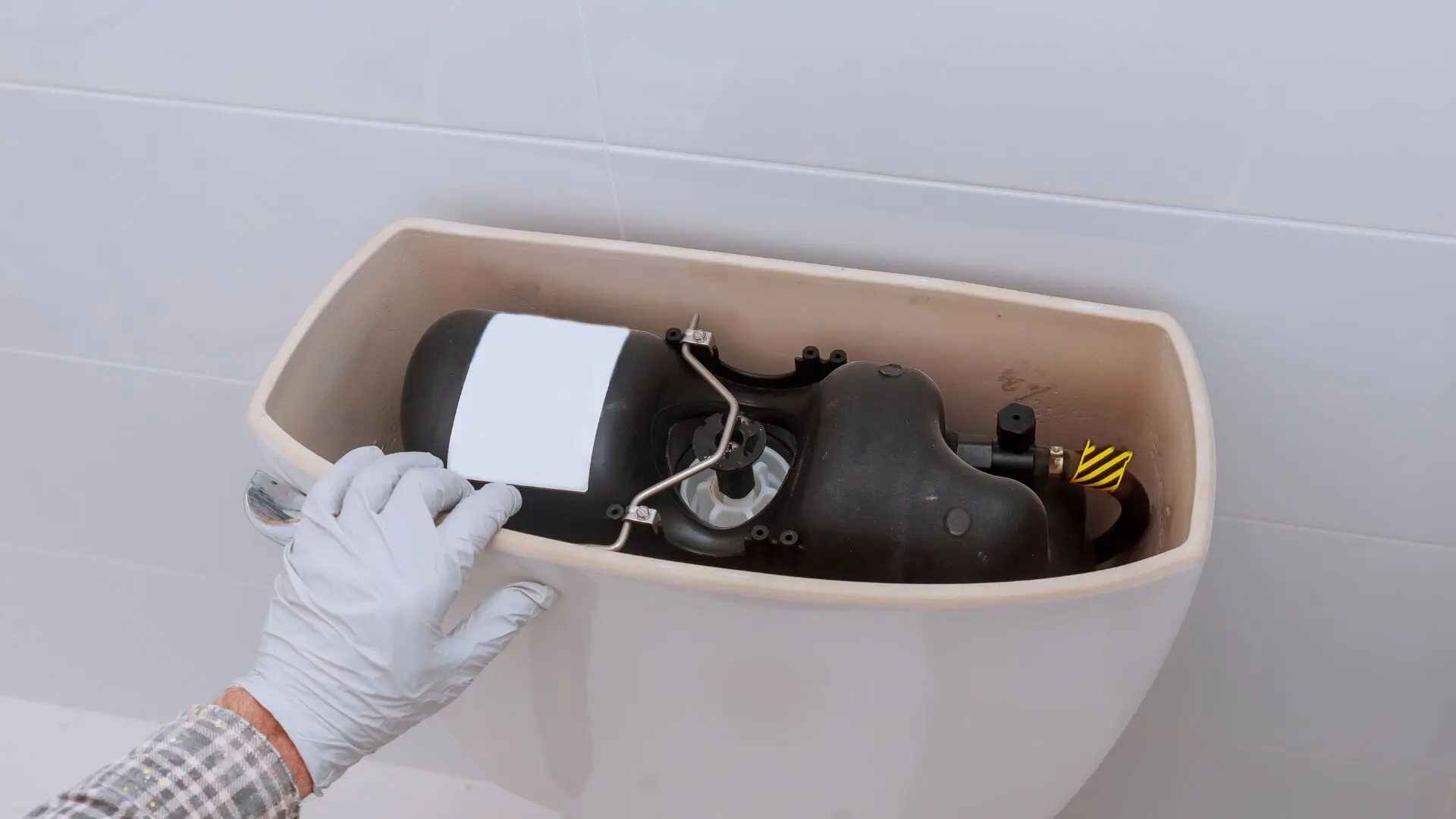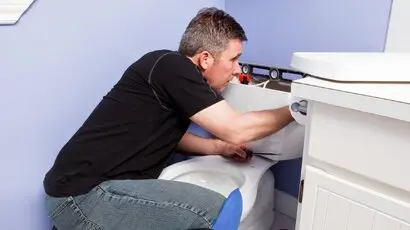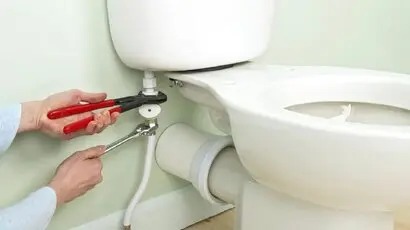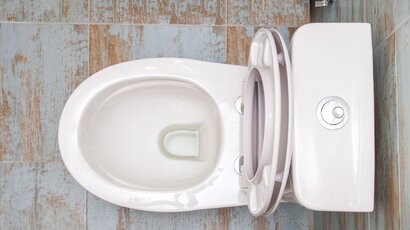A clean and hygienic bathroom is essential for maintaining a healthy home environment, and the toilet cistern is an often-overlooked area that requires regular attention. A neglected toilet tank can become a breeding ground for bacteria, leading to unpleasant odours and potential health hazards. A build-up of mineral deposits and grime can impede the toilet’s flushing efficiency, resulting in increased water usage and potential plumbing issues.
Keeping your bathroom fresh and clean means adding toilet cistern cleaning to your regular routine. We’re here to give you some expert advice on cleaning and disinfecting your toilet cistern. In doing so, you’ll be able to tackle tough stains, mineral build-up, and bacteria effectively.
Follow these easy steps, and your toilet tank will stay sparkling clean, helping you maintain a healthier home and avoid plumbing issues. Let’s dive into the best ways to keep your toilet cistern impeccable.
Why Clean Your Toilet Cistern?
![]()
Cleaning your toilet cistern is a task that many homeowners often overlook. However, there are several important reasons why you should make it a regular part of your bathroom maintenance routine:
- Prevent Bacteria and Mould Growth: The damp environment inside your toilet tank is a breeding ground for bacteria and mould, which can cause unpleasant odours and potential health hazards.
- Ensure Proper Flushing Functionality: Mineral build-up and debris can clog the internal components of your toilet tank, leading to weak or incomplete flushes.
- Extend the Life of Your Toilet: Regular cleaning and maintenance can help prevent corrosion, rust, and damage to the internal components, saving you money on costly repairs or replacements.
- Improve Water Efficiency: A clean toilet cistern ensures the fill valve functions properly, reducing water waste and lowering monthly water bills.
- Maintain a Fresh and Pleasant Bathroom Atmosphere: A dirty toilet tank can emit foul odours that permeate the entire bathroom, creating an unpleasant environment.
Gather Necessary Cleaning Supplies
Before you begin cleaning the toilet tank, gather all the necessary supplies. You’ll need rubber gloves to protect your hands, a face mask to avoid inhaling cleaning product fumes, a scrub brush or sponge for scrubbing, a disinfectant spray or cleaning solution, and white vinegar for a natural cleaning alternative. Make sure to choose cleaning products that are safe for use in toilet cisterns to avoid damaging the internal parts.
Prepare the Toilet Cistern for Cleaning
Before you begin cleaning your toilet cistern, it’s essential to properly prepare the tank to ensure a safe and effective cleaning process. Follow these steps to get your toilet tank ready for a deep clean:
![]()
1. Shut off the Water Supply
Locate the water supply valve near the toilet’s base or the wall behind it. Turn the valve clockwise to shut off the tank’s water supply completely. This will prevent any water from entering the cistern during the cleaning process.
2. Empty the Tank
Flush the toilet to drain the water from the tank. Hold down the flush lever until the tank is empty, ensuring no water remains in the cistern.
3. Remove Excess Water
Use a sponge, cloth, or paper towel to soak up any remaining water at the bottom of the tank. Squeeze the excess water into a bucket or the toilet bowl, and dispose of any used paper towels.
4. Remove the Tank Lid
Carefully lift the tank lid off the cistern and set it aside on a stable surface. If the lid is heavy or difficult to remove, consult your toilet’s user manual or seek assistance to avoid damaging the lid or injuring yourself.
5. Assess the Tank’s Interior
Take a moment to examine the inside of the toilet tank, noting the level of mineral build-up, rust, and grime present. This will help you determine the most appropriate cleaning method and the cleaning products needed to tackle the job effectively.
6. Protect Surrounding Area
Place towels or a protective covering around the toilet’s base to catch any drips or spills during the cleaning process.
Clean and Disinfect the Cistern
Now that your toilet cistern is properly prepared for cleaning, it’s time to tackle the grime, mineral build-up, and accumulated stains over time. Follow these steps to thoroughly clean and disinfect your toilet tank:
1. Scrub the Tank’s Interior
Using a sturdy scrub brush or sponge, scrub the inside of the tank to loosen and remove dirt, grime, and mineral deposits. Pay special attention to the corners, crevices, and hard-to-reach areas where sediment is most likely to accumulate. Apply a bit of elbow grease to ensure that all surfaces are thoroughly scrubbed.
For stubborn stains or rust marks, create a cleaning paste using a pumice stone or a mixture of baking soda and white vinegar. Apply the paste directly to the affected areas, allowing it to sit for several minutes to penetrate the stains. Then, scrub the treated areas vigorously to lift the stains and reveal a cleaner surface.
2. Apply Disinfectant
Once you’ve removed the visible grime and stains, it’s crucial to disinfect the tank to eliminate harmful bacteria and ensure a hygienic environment. You can use a store-bought disinfectant spray or cleaning solution, following the manufacturer’s instructions for proper application and dwell time.
Alternatively, create your own cleaning solution by mixing equal parts water and white distilled vinegar. Pour the mixture into the tank, ensuring that all surfaces are covered, and allow it to soak for several hours or overnight for optimal results.
3. Re-Scrub and Rinse
After soaking, thoroughly scrub the tank to loosen any remaining mineral build-up and grime. Use your scrub brush or sponge to agitate the surfaces, paying extra attention to the areas around the flush valve, chain, and other components.
Once you’ve finished scrubbing, use a microfiber cloth or sponge to wipe down the metal parts and remove any stubborn stains.
4. Flush and Inspect
Once you’re done cleaning and disinfecting, flush the toilet several times to wash away any residue and check the flushing mechanism. Look inside the tank to make sure it’s spotless and free from grime or stains.
Reassemble and Flush
Once you’ve completed the deep clean, it’s time to reassemble the toilet tank. Replace the lid and reconnect the water supply by turning the water valve back on. Flush the toilet several times to rinse any cleaning residue and ensure the flushing mechanism works correctly. Check for any leaks or issues with the water flow and adjust as needed.
Maintaining a Clean Cistern
![]()
Adopt a regular maintenance routine to keep your toilet cistern clean between deep cleanings. Use toilet tablets that dissolve slowly, releasing cleaning agents to prevent bacteria growth and mineral deposits. Another solution is adding a cup of white vinegar to the tank weekly, letting it sit for several hours before flushing.
Address any leaks or malfunctions promptly to prevent water damage and mould growth.
Establish a regular cleaning schedule based on water mineral content and frequency of use. Clean the tank every few months to prevent grime and mineral build-up and maintain a fresh bathroom.
Additional Tips for a Hygienic Bathroom
In addition to cleaning the toilet tank regularly, keeping the toilet bowl clean and disinfected is essential. Use a toilet brush and a cleaning agent designed for toilets to scrub the bowl, paying attention to the rim and under the toilet seat. Wipe down the exterior of the toilet, including the seat and lid, with a disinfectant spray or bleach solution to maintain a hygienic bathroom.
A Fresh and Hygienic Bathroom Starts with a Clean Cistern
Keeping your toilet cistern clean and disinfected is key to a fresh, hygienic bathroom. Follow these expert tips, use the right products, and you’ll effectively remove mineral build-up, stubborn stains, and bacteria.
Regular maintenance and deep cleanings will ensure your toilet functions properly and keep your bathroom smelling clean and pleasant. Incorporate these toilet cistern cleaning tips into your bathroom cleaning routine for a healthier and more inviting home.
For professional assistance with your toilet cistern or any other plumbing needs in Melbourne, contact WP Plumbing. Our experienced team is dedicated to providing high-quality plumbing services to keep your bathroom functioning at its best. Call WP Plumbing today to schedule your service and enjoy a clean, fresh, and properly maintained bathroom.
Frequently Asked Questions
Why is it important to keep your toilet tank clean?
A clean toilet tank is essential for maintaining a sanitary toilet and preventing bacteria growth. Mineral build-up and grime can impede the flushing efficiency, leading to increased water usage and potential plumbing issues. Regular cleaning also helps maintain a fresh and pleasant scent in your bathroom.
What cleaning products should I use to clean my toilet cistern?
When cleaning your toilet cistern, avoid harsh chemicals that may damage the internal components. Instead, use a mild disinfectant spray or create a natural cleaning solution using equal parts water and white vinegar. For tough stains or rust stains, make a paste using baking soda and white vinegar and apply it directly to the affected areas.
How long should I let the cleaning solution sit in the toilet tank?
For optimal results, allow the cleaning solution, such as a mixture of water and white vinegar, to sit overnight in the toilet tank. This will give the solution ample time to break down mineral deposits, grime, and bacteria. After letting it sit overnight, thoroughly scrub the tank’s interior and flush to rinse away any residue.
How often should I clean my toilet cistern to maintain a sanitary toilet tank?
The frequency of cleaning your toilet cistern depends on factors such as the mineral content of your water (hard water can lead to more rapid build-up) and the frequency of use. As a general rule, aim to deep clean your toilet tank every one to three months to prevent excessive grime accumulation and ensure a clean tank.
Additionally, maintain a regular cleaning routine by adding a cup of white vinegar to the tank weekly and using toilet tablets to keep the overflow valve and other components clean between deep cleanings.






